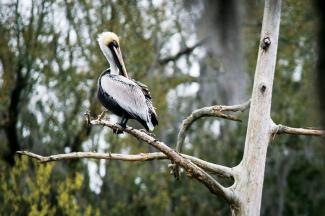A mother pelican with the species’ distinctive long beak is depicted as the Pelican in Her Piety on the state flag. She’s nourishing her brood of chicks with her own blood.
That’s where the idea: not for one’s self, but for one’s own, Tulane’s motto, came from.
The tortuous, fraught saga of the brown pelican has fascinated artists and writers for eons. The brown pelican faced extinction because of pesticides in the 1970s — and recovered. The bird then endured the BP Oil Spill of 2010. It’s now defended by the Louisiana Coastal Protection Restoration Authority and is experiencing a fragile resurgence.
Rien Fertel tells this amazing story in Brown Pelican (Louisiana State University Press, 2022). Fertel earned his BA and PhD from Tulane and is a visiting assistant professor in the Department of History at Tulane’s School of Liberal Arts.
Fertel became intrigued by the pelican when he read that the artist Walter Anderson loved pelicans so much that he lived alone with them for a time on the Chandeleur Islands at the edge of the Louisiana boot in the Gulf of Mexico.
“The story of this bird can, at times, be a bleak one,” said Fertel, “with several near and real extinction events. But I hope readers learn that because of past and through future human engagement the brown pelican has, can, and will thrive.”
Fertel asks existential questions in this age of climate change and rising sea levels: “What will become of the brown pelican? What will become of us? A bioindicator species, the brown pelican just might be the greater Gulf’s canary on the coastline.”































































